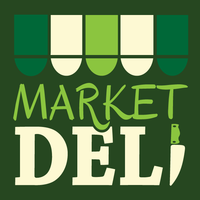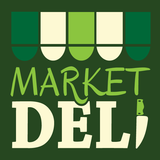About Us
Market Deli is a small family business that has been serving the people of Cardiff for five generations, expanding from just one stall in Cardiff Market in 1906.
We serve some delicious food to eat straight away or to take home favourites include our Chicken Madras, Chinese Chicken Curry and Lasagne. Our dishes are prepared fresh daily along with a wide selection of cooked meats, pies, pasties, filled rolls and salads. Within Stalls 8-12, you’ll also find fresh farm produce such as chickens, eggs, stuffing and turkeys at Christmas.
Come and visit our stall and meet our friendly team, you won’t be disappointed.
Click to see our current Food Hygiene Rating
The History of Market Deli
In 1906, William Dolbear took on a stall within Cardiff Market, selling rabbits. In 1912 he passed this business on to his daughter Ethel and her new husband Thomas Griffiths who continued to work in the market 6 days a week. By 1928, it was time to pass the business on to their son Thomas Daniel, who slowly expanded the business taking over the two neighboring stalls, and extending the range to include poultry. Thomas Daniel ran the business along with his wife Mary, until sadly he passed on in 1970, leaving Mary to run the business with her son Martin. After Mary sadly passed in 2001, Martin decided it was time to seek out pastures new, and his son Andrew, along with his business partner Geoff, took the reigns, and continue to run the business today.
The History of Cardiff Market
1700’s
The Cardiff market was not only the place where farmers from the surrounding countryside bought and sold livestock and sold their produce, it was also where townspeople bought their household supplies of fresh food including meat, corn, butter and cheese – and other goods such as wool, cloth and earthenware. As late as the 1790’s there were only 25 retail shops in Cardiff, most purchases of everyday necessities still had to be made from stalls in the market place under the town hall. A new town hall was built in High Street in the 1740’s. The main entrance to the market hall on the ground floor was under steps, but there were also arcades open to the street. This hall stood in High Street until 1861.
1800’s

Gild hall in High Street dating from the 1850’s. In front stands the statue of John, 2nd Marquess of Bute which is now to be found at the southern end of St Mary Street. Between 1810 and 1820 the weekly market was held in the open street on Saturday, in High Street. For butchers’ meat, vegetables, earthenware and casual commodities, the space allotted was from the Town Hall to the Castle.
The greater portion of butchers’ meat was bought from the country. Meat at this time was sold by hand, each joint bargained for between butcher and buyer. During the great fairs, High Street was used for saleable articles; in the market space, under the Hall, the tables were used for cloth and flannel weavers.
“Sourced by Cardiff Central Library from the book ‘Cardiff Central Market 1891 – 1991’ (Survey of Cardiff, Occasional Paper No. 5, 1991)”.
Essential though the markets and fairs were to the life and prosperity of Cardiff, the inconvenience of having a town hall and market house in the middle of one of the main streets, with the market activities spilling out on to High Street and St Mary Street was increasingly felt. The Cardiff Street Commissioners, made the first modest attempt to improve matters by obliging the stallholders to clear the pavement of obstruction so that Sunday churchgoers would not be inconvenienced. A proposal to demolish the town hall and rebuild it elsewhere was made as early as 1797, by which date High Street and St Mary Street were becoming more important as thoroughfares.
The first practical steps were left to William Vachell who in 1822 erected a covered market on a plot which he owned in High Street. Vachell operated his market with great success, the Corporation had approved his venture while insisting on their right to collect tolls due to them under the borough charters. The market was later discontinued with the opening of the corporation’s own covered market in 1835.
The erection of a covered market for the sale of meat and fresh food was clearly a great improvement, facilitating the movement of traffic through the town on market days. It also meant that fresh produce was on sale throughout the week and not just on Saturday. But cattle and other livestock were still tethered and penned in the streets, obstructing traffic and fouling the carriageway. In 1829 the corporation purchased a site at the back of Quay Street for a pig market.
By the 1820’s it was clear that Cardiff needed a modern covered market to replace the old gildhall in High Street. In 1835, the Burgesses decided to build a new market. The market was designed by Edward Haycock, and the market was made of a large iron framed shed. The main entrance was on St Mary Street where part of the frontage continued to be occupied by a pair of cottages and the lock up, of which the latter was superseded by a borough police station in 1855. There was a second entrance to the market from Church Street through the Old Arcade, which survives today as a way into the present market.
In 1883, Solomon Andrews one of Cardiff’s leading Victorian entrepreneurs put forward a scheme for a new market which included a block of shops and offices on St Mary Street frontage and a rebuilt market hall behind. Andrews had no more success than the borough engineer had in the past, but the rejection of the plan by the corporation seems to have led directly to the erection of Market Buildings on St Mary Street. In 1884 he took a lease for the entire street frontage, including the police station, Edward Haycock’s market entrance and the two small cottages in between. He then erected a huge new building with four floors which for a time overshadowed adjoining buildings, until James Howells extended his store on the same scale.

The second Market Buildings (1886) designed by J.P. Jones for Solomon Andrews. The Opening of Cardiff Central Market - 1891
A plan was adopted for Cardiff Market in 1890 and Haycock’s market of 1835 closed for demolition. In August of that year a memorial stone was laid for the new market which was officially opened on 8 May 1891. The new central market was designed on broadly similar lines to that of 1835, except that the St Mary Street entrance was provided by the existing archway beneath Market Buildings.
The market was designed by the borough engineer William Harpur, and consisted of a large wrought iron shed running from the back wall of Market Buildings through to Trinity Street.
The main market hall had stalls down each side and on either side of four aisles, with a balcony on all four sides of the hall. In all, 349 stalls were provided in the original layout, ranging from simple open counters to lock ups. There was a determined attempt to group tenants by trade to confine non-food sales to the balcony in an effort to ensure that shoppers did venture upstairs. A raised office for the market superintendent was provided on the ground floor surmounted by a clock tower.
The Central Market was opened on 8 May 1891 by the Lady Mayoress of the day, the Marchioness of Bute. A plaque to commemorate the occasion can still be seen near the Trinity Street entrance.
1900’s

Cardiff Central Market was clearly a popular feature of shopping in late Victorian Cardiff, complimenting the arcades as a location for small, specialist retailers.
The market now represents one of the main outlets in the centre for fresh fish, meat and vegetables while at the same time offering a wide variety of non-food goods. This traditional Victorian market remains a well established landmark in the history of Cardiff.
“The photographs/drawings displayed on this website have been taken from the book ‘Cardiff Central Market 1891 -1991’ (Survey of Cardiff, Occasional Paper No. 5, 1991). Every effort has been made to identify ownership, but copyright remains unknown. This information was taken from www.cardiff-market.co.uk and permission to use this information was kindly granted by Nicola Burrows on the 15th of September 2006.
Dic Penderyn And Cardiff Market

Dic Penderyn – real name Richard Lewis was a Welsh working class martyr. He was born in Aberavon, West Glamorgan in 1808 but in 1819 the family moved to Merthyr Tydfil where Dic joined his father at work as a miner. At the age of 15, Dic began to earn a reputation as a fighter for workers’ rights.
During the industrial revolution, wages within the Iron Industry were high, but unfortunately the “golden age” did not last forever and in 1829 a depression hit the iron industry that would last for 3 long years. The working class were immediately plunged into hardship. Bailiffs, authorised by the Court of Requests which was set up in 1809, moved in to seize the property of the unfortunate debtors.
In 1831 the Merthyr Rising begun, in protest against the actions authorised by the Court of Requests. On the morning of Friday 3 June 1831, soldiers and an angry crowd of 2,000 confronted each other outside the Castle Inn in Merthyr. It was this confrontation that saw Dic Penderyn arrested for allegedly stabbing a soldier called Donald Black. Although Donald Black did not identify Dic Penderyn he was sentenced to death.
Dic Penderyn felt that he was being held responsible for the actions of others, still protesting his innocence he was hung on the gallows in St Mary Street, Cardiff (now the foyer of Cardiff Central Market) on Saturday 13 August 1831, aged 23 years.
The last words that passed his lips before he was hung were, "O Arglwydd, dyma gamwedd" which translates as "Oh Lord, here is injustice".
A customary gathering in the foyer of Cardiff Central Market, St Mary Street, to commemorate Dic Penderyn and to also honour the work of the late Councillor Charlie Gale, who did so much to make this day a fixture in the Cardiff Calendar so that it can be acknowledged on the 13 August every year.
This information was taken from www.cardiff-market.co.uk and permission to use this information was kindly granted by Nicola Burrows on the 15th of September 2006.



